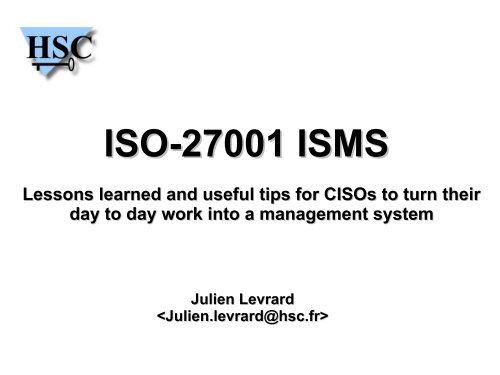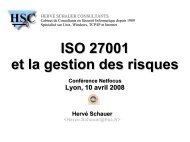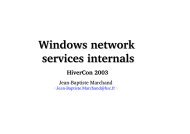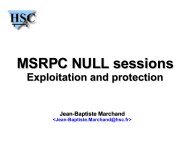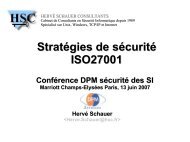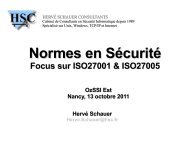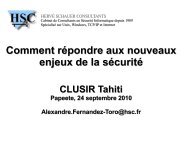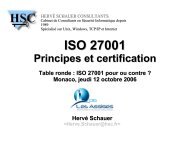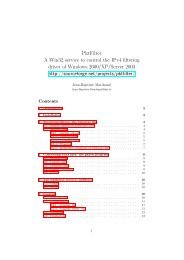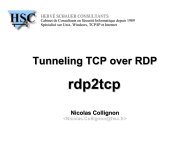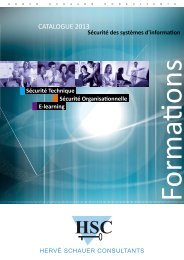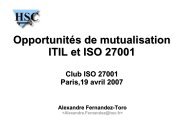PDF version - Herve Schauer Consultants
PDF version - Herve Schauer Consultants
PDF version - Herve Schauer Consultants
Create successful ePaper yourself
Turn your PDF publications into a flip-book with our unique Google optimized e-Paper software.
ISO-27001 ISMS<br />
Lessons learned and useful tips for CISOs to turn their<br />
day to day work into a management system<br />
Julien Levrard<br />
Hervé <strong>Schauer</strong> <strong>Consultants</strong><br />
IT security company founded in 1989<br />
Fully independent intellectual expertise services<br />
Free of any distribution, integration, outsourcing, staff delegation or outside investors pressure<br />
Services: Consulting, coaching, audits, pentests, training<br />
Fields of expertise<br />
Technical security<br />
OS, Network, Application, industrial systems, infrastructure<br />
Organizational security<br />
IS management, Risk management, ISO-27001, PCI DSS, ARJEL, HDS<br />
Business Continuity<br />
Legal<br />
Certifications<br />
CISSP, ISO 27001 Lead Auditor, ISO 27001 Lead Implementor, CISA, PCI-DSS QSA, ISO<br />
27005 Risk Manager, ITIL, GIAC GCFA, GIAC GPEN, OPQCM, OPQF, etc.<br />
2<br />
Copyright Hervé <strong>Schauer</strong> <strong>Consultants</strong> 2003-2013
Objective:<br />
The need for an HSC ISMS framework<br />
– Unify our way of implementing ISMS<br />
– Capitalize the lessons learnt within our<br />
engagements<br />
– Generic framework that should be simple<br />
enough to be understood by a business<br />
manager in 5 min<br />
– Logical segregation of ISO-27001 requirements<br />
How to do it:<br />
– Think as “the management”<br />
3<br />
Copyright Hervé <strong>Schauer</strong> <strong>Consultants</strong> 2003-2013
Security controls<br />
Premise n° 1:<br />
No organization has been<br />
waiting any ISO standard<br />
to implement security<br />
controls<br />
4<br />
Copyright Hervé <strong>Schauer</strong> <strong>Consultants</strong> 2003-2013
Security controls management<br />
Security<br />
controls<br />
mngt<br />
Do we know<br />
– What security controls are in<br />
place or planned<br />
– What activities are associated<br />
to these controls and who is in<br />
charge of them<br />
Premise n°2:<br />
We expect the CISO to be able to<br />
answer those questions<br />
5<br />
Copyright Hervé <strong>Schauer</strong> <strong>Consultants</strong> 2003-2013
Mandatory compliance management<br />
Legal and and<br />
contractual<br />
compliance<br />
Security<br />
controls<br />
mngt<br />
Did the CISO identify<br />
– Legal and contractual<br />
requirements regarding<br />
Information Security<br />
– What security controls should<br />
be implemented in order to<br />
cover them<br />
Premise n°3:<br />
The CISO knows what are the<br />
mandatory security requirements<br />
the organization is subject to and<br />
what to do to keep people out of jail<br />
6<br />
Copyright Hervé <strong>Schauer</strong> <strong>Consultants</strong> 2003-2013
IS risks management<br />
Did the CISO identify/understand<br />
Security<br />
controls<br />
mngt<br />
IS IS risks<br />
– What the interested parties<br />
expectations are<br />
– The important processes and<br />
information that should be protected<br />
Are information security expenses efficient<br />
Does the CISO have a good understanding<br />
of the information system<br />
Premise n°4:<br />
The CISO understand the business risks<br />
and is capable of interpreting them as<br />
information system risks and pilot the<br />
security expenses according to those<br />
risks<br />
7<br />
Copyright Hervé <strong>Schauer</strong> <strong>Consultants</strong> 2003-2013
IS incident management<br />
Security<br />
controls<br />
mngt<br />
Premise n°5:<br />
If a severe incident is badly<br />
managed, the CISO loses<br />
his job<br />
Incidents<br />
8<br />
Copyright Hervé <strong>Schauer</strong> <strong>Consultants</strong> 2003-2013
Summary of the 5 premises<br />
Legal and and<br />
contractual<br />
compliance<br />
Security<br />
controls<br />
mngt<br />
IS IS risks<br />
No organization has been waiting any ISO<br />
standard to implement security controls<br />
We expect the CISO to know what security<br />
controls are in place and who is in charge of<br />
them<br />
The CISO knows what are the mandatory<br />
security requirements the organization is<br />
subject to and what to do to stay out of jail<br />
Incidents<br />
The CISO understands the business risks<br />
and is capable of interpreting them as<br />
information system risks and pilot the security<br />
expenses according to them<br />
If a severe incident is badly managed, the<br />
CISO loses his job<br />
9<br />
Copyright Hervé <strong>Schauer</strong> <strong>Consultants</strong> 2003-2013<br />
These 5 premises are applicable to any<br />
organization that pretends managing<br />
information security
Information Security management system (ISMS)<br />
Legal and and<br />
contractual<br />
compliance<br />
IS IS risks<br />
Implementation of P-D-C-A way<br />
of working for all security<br />
management activities<br />
Continual<br />
improvement<br />
Monitoring<br />
and and review<br />
Security<br />
controls<br />
mngt<br />
Incidents<br />
Doc. Doc.<br />
Resources<br />
and and skills skills<br />
– Documentation management<br />
– Records management<br />
– Resources management<br />
– Training and awareness<br />
management<br />
– Monitoring and review<br />
– Continual improvement<br />
10<br />
Copyright Hervé <strong>Schauer</strong> <strong>Consultants</strong> 2003-2013
How to comply with ISO-27001<br />
Legal and and<br />
contractual<br />
compliance<br />
Continual<br />
improvement<br />
Monitoring<br />
and and review<br />
Management<br />
ISMS Steering<br />
Security<br />
controls<br />
mngt<br />
Incidents<br />
IS IS risks<br />
Doc. Doc.<br />
Resources<br />
and and skills skills<br />
Formally involve the<br />
management<br />
Formalize information security<br />
management processes<br />
Formalize mandatory<br />
documents and records:<br />
– Statement of Applicability<br />
– ISMS policy and perimeter<br />
– Risk assessment<br />
methodology<br />
– Etc.<br />
11<br />
Copyright Hervé <strong>Schauer</strong> <strong>Consultants</strong> 2003-2013
HSC ISMS model<br />
Legal and and<br />
contractual<br />
compliance<br />
Continual<br />
improvement<br />
Management<br />
ISMS Steering<br />
Security<br />
controls<br />
mngt<br />
IS IS risks<br />
Doc. Doc.<br />
Represents best practices in<br />
information security management<br />
Relevant for any type of organization<br />
(just like the standard)<br />
Easy to understand and accessible to<br />
management and business owners<br />
Segregates the ISMS in logical<br />
activities<br />
– Eases maturity assessment<br />
Monitoring<br />
and and review<br />
Incidents<br />
Resources<br />
and and skills skills<br />
– Structures the ISMS project plans<br />
Directly usable as a framework<br />
– For initial assessment<br />
– For implementation project<br />
– For internal audit<br />
12<br />
Copyright Hervé <strong>Schauer</strong> <strong>Consultants</strong> 2003-2013
Implementation feedback and advice<br />
for the clueless CISO<br />
13<br />
Copyright Hervé <strong>Schauer</strong> <strong>Consultants</strong> 2003-2013
An ISMS is not a compliance project<br />
Do not<br />
Drive your implementation project following the standard<br />
sequentially<br />
– With the ISMS seen as a compliance project<br />
– Using a GRC tool to drive your implementation<br />
But do:<br />
Use a solid information security management framework<br />
– Customized to fit your actual information security organization<br />
14<br />
Copyright Hervé <strong>Schauer</strong> <strong>Consultants</strong> 2003-2013
Think “Run” as soon as possible<br />
Do not:<br />
– Implement an ISMS without anticipating the ISMS after its certification<br />
●<br />
The standard is strongly mixing:<br />
– The target: A state of the art IS management<br />
– The project steps to reach the target<br />
– Appoint only a project manager<br />
●<br />
But do:<br />
And forget to appoint a CISO<br />
– Anticipate the “run” phase during the “build” one<br />
– Project activities → Continual improvement<br />
– Risk assessment interviews → Internal audit interviews<br />
– Project manager → CISO<br />
15<br />
Copyright Hervé <strong>Schauer</strong> <strong>Consultants</strong> 2003-2013
Do not:<br />
Segregate management controls from risk<br />
reduction controls<br />
– Consider all 133 annex A security controls to mitigate technical risks<br />
●<br />
●<br />
●<br />
But do:<br />
Some controls reduce all risks:<br />
– A.5.1.1, A.6.1.1, A.8.2.2, A.15.1.1 …<br />
So we have to select them anyway<br />
It's difficult to measure how risks are reduced by these controls<br />
– Consider these security controls as management process activities<br />
– Focus risk assessment on technical risks and associated security<br />
controls (A.9, A.10, A.11 and A.12)<br />
– Turn your “compliance oriented” risk assessment into an operational<br />
document that you can share with technical staff<br />
16<br />
Copyright Hervé <strong>Schauer</strong> <strong>Consultants</strong> 2003-2013
Be a guide, not a pen-pusher<br />
Do not:<br />
– Try to implement an ISMS without the operational staff's involvement<br />
regarding security controls<br />
●<br />
●<br />
●<br />
But do:<br />
Documentation, monitoring<br />
Weak link between CISO and staff<br />
It's often easier to document and manage documentation of security<br />
controls on your own or with consultants but:<br />
– The ISMS will not be working and it will lead to a double security<br />
controls documentation with inconsistency issues<br />
– Help, explain, guide, support, check, monitor, train (but do not do their<br />
job)<br />
– Find support within middle management to enforce your requests<br />
17<br />
Copyright Hervé <strong>Schauer</strong> <strong>Consultants</strong> 2003-2013
Create your own security controls<br />
management tools<br />
Do not :<br />
– Use SOA as a tool for managing security controls, or worst, as a<br />
risk treatment plan<br />
● Except if you like the way it's organized ;-)<br />
●<br />
But do:<br />
It will lead to a painful and laborious way to manage your<br />
security controls<br />
– Arrange you security controls list the way they are actually<br />
operated and managed<br />
– Use the SOA to check completeness and to communicate with<br />
the auditor<br />
– Consider formalizing a high level global RTP and specific<br />
operational RTPs (HR, IS, Business, etc.)<br />
18<br />
Copyright Hervé <strong>Schauer</strong> <strong>Consultants</strong> 2003-2013
Check, check, check and check again<br />
Do not:<br />
– Neglect monitoring and review activities<br />
●<br />
●<br />
●<br />
It's the CISO's strongest tool to validate the work<br />
With no M&R, the CISO stays on a theoretical level and do not identify<br />
operational issues<br />
The ISMS is one-way (IS policy style)<br />
– Underestimate the internal audit costs<br />
– Underestimate the cost of adequate records and indicators<br />
But do:<br />
– Formally monitor the project progress and RTP implementation<br />
– Invest strongly from the beginning of the project in monitoring of<br />
security controls efficiency<br />
– Link all audit activities to the ISMS (Pentest, SOX, ISAE 3402, etc.)<br />
19<br />
Copyright Hervé <strong>Schauer</strong> <strong>Consultants</strong> 2003-2013
What are we working on<br />
20<br />
Copyright Hervé <strong>Schauer</strong> <strong>Consultants</strong> 2003-2013
Work in progress<br />
Legal and and<br />
contractual<br />
compliance<br />
Continual<br />
improvement<br />
Management<br />
ISMS Steering<br />
Security<br />
controls<br />
mngt<br />
IS IS risks<br />
Doc.<br />
Continual improvement with<br />
consultants field feedback<br />
Improvement of best-practices for each<br />
process<br />
Optimization of our engagement and<br />
improvement of quality<br />
Integration of other security<br />
frameworks within the ISMS:<br />
– Health Care data<br />
Monitoring<br />
and and review<br />
Incidents<br />
Resourc<br />
es es and<br />
skills<br />
– PCI DSS<br />
– Online gaming<br />
– SOX/ISAE-3402<br />
Automation of indicators management<br />
to monitor the ISMS<br />
21<br />
Copyright Hervé <strong>Schauer</strong> <strong>Consultants</strong> 2003-2013
Questions <br />
<br />
22<br />
Copyright Hervé <strong>Schauer</strong> <strong>Consultants</strong> 2003-2013


